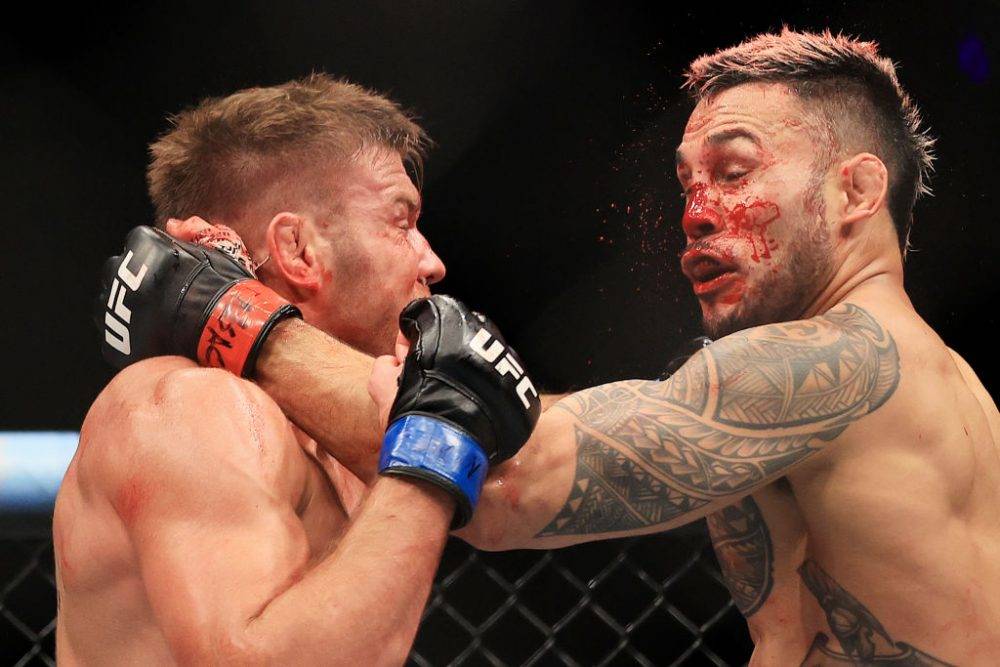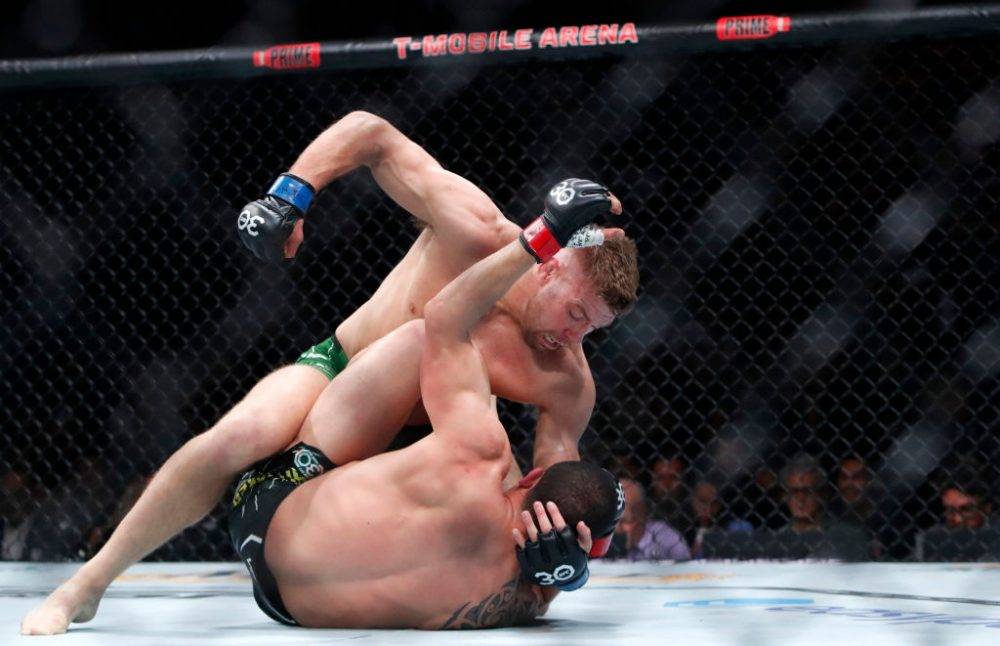Unbeaten: Dricus Du Plessis celebrates after defeating Robert Whittaker in a middleweight bout during UFC 290 at T-Mobile Arena in July in Las Vegas, Nevada. This lined du Plessis up for a title shot. (Photo by Steve Marcus/Getty Images)
On the 19th of October, the Mail & Guardian visited the CIT Performance Institute and spoke to UFC star Dricus du Plessis ahead of UFC294. WATCH THE FULL INTERVIEW HERE:
(Video by Lesego Chepape and edited by Eyaaz Matwadia)
In July 2021, on the Conor McGregor vs Dustin Poirier Ultimate Fighting Championship (UFC) card, a South African fighter debuted on pay-per-view with a vicious knockout win over Trevin Giles.
He then took the mic and said to UFC commentator Joe Rogan, “Dricus du Plessis. Remember the name. It will be a household name in the top 10 very soon.”
Since then, Du Plessis has made a phenomenal rise to the top of the middleweight division by winning four fights and pillaging any competition the company has put in front of him. He was rewarded with the number one middleweight ranking in July after he beat former champion Robert Whittaker.
Where the magic happens
The Mail & Guardian visited the CIT Performance Institute — the place where Du Plessis trains — and, from 8:30am, there were fighters on the training mats embodying the cliché “blood, sweat and tears”.
But, when Du Plessis walked into the gym at 10am, the energy in the place shifted into a new gear. The fighters followed his lead as he took to the mat for a light warm-up and then began a striking session.
Du Plessis, who is now the team captain at CIT, said it’s not easy to train every day, but it’s something he demands from his teammates and he tries to lead by example.
“We always try to keep a certain level of culture in this gym. We try to keep the excitement,” Du Plessis said.
“I expect the best from all of my teammates and they expect the same from me. I believe that in order to bring the best out of them, I need to be an example. At the end of the day, we do fight for this team and we do fight for each other.”
As advertised on TV, Du Plessis provided a striking clinic, showing how his years in the UFC have helped him become a much more calculated striker. But that’s not to discredit the work that has been done by the CIT to help the fighter reach this level.
Du Plessis is proud of this gym and is glad that it is finally getting recognition on the global stage in mixed martial arts.
‘Inspiration’
Du Plessis has now become the inspiration for young fighters. He is the first South African mixed martial artist to make it big in the UFC.
Jiu-jitsu coach Wayne Harrison said there are two youngsters at the gym who have dropped out of school to focus on careers in mixed martial arts. They have seen the fruits of the hard work Du Plessis and Cameron Saaiman — another UFC fighter from South Africa — have enjoyed and thus dedicated their lives to the sport.
When Du Plessis was coming up, there were no South African fighters gunning for gold in the UFC. But he still found his inspiration in local fighters.
“There were so many guys [that inspired me]. I wouldn’t say there was one specific person that made me fall in love with the sport as a little boy. But once I started getting into it at 14 or 15, guys like my former teammate Leon Mynhardt and Michiel Opperman, who were both EFC champions, inspired me.”
He also attributes a large part of his success to his coach, Morné Visser, who also coached Mynhardt and Opperman.
Du Plessis eventually shared the mat with both athletes, who he considers mentors.
Signed to the UFC
You would have only know about Du Plessis, or “Stillknocks” as he is known when he fights, if you followed the South African promotion Extreme Fighting Championship (EFC) or the Polish promotion Konfrontacja Sztuk Walki (KSW).
Du Plessis was a two-division champion in South Africa and the Welterweight champion in KSW.
But it all changed in 2018 when he got a call to go to the United States to help UFC fighters prepare for their fights. At this point, he was still trying to climb the ladder in the mixed martial arts world and reach the pinnacle, which is the UFC.
Du Plessis enjoyed that experience, because it helped him understand that being the best fighter in the world was no longer a dream he was chasing.
“You see these guys fight on TV, they look huge and then you realise that they’re not bigger than me and they are not that much better. Yes, there are certain areas where they are better than me and things I need to work on, but then again there are certain areas where I’m better.
“I started gaining that self-belief. That experience was a massive learning curve for me. I stayed there for a month or six weeks and my confidence just grew. I would say about two years after my first visit to the US, I got signed to the UFC.”
But Du Plessis still had to wait for the call to get a fight and it could not have come at a worse time.
During the Covid hard lockdown in 2020, he got a call to fight on 10 days notice. Fighters usually have a six to eight-week training camp to prepare for a fight. But it was not an opportunity that he could let slip by.
“I was not in great shape, because it was Covid. We were in a hard lockdown, but I was still training. We took equipment to my house and trained there,” Du Plessis said.
Du Plessis won the fight by knockout in the first round and added, “it was not an ideal situation, but you can’t say no to an opportunity like that and today, I’m the number one ranked middleweight in the world”.
Favourite fight since joining the UFC
Du Plessis has made light work of many opponents in the UFC. From ranked opponents like Derek Brunson to former champion Robert Whittaker, he has rarely let his fights go the distance.
But the one fight that did need the judges to make a decision was the fight that gained a lot of attention thanks to the sheer brutality of it.
It was his third fight in the UFC, and his opponent was American fighter Brad Tavares. The fight went the full three rounds and although Stillknocks edged out a decision, the UFC commentary team applauded the fight calling it a war.
Du Plessis recalls losing the first of three rounds in this fight. He said that after winning the second round, the final round came down to a test of will. He said that till now, this is his favourite fight that he has seen “as a fan”.
“Brad Tavares was one of the toughest people I fought. In terms of being tired and in terms of taking damage, I wouldn’t call it my toughest fight. I hit that guy and the next day, my hands were swollen. I normally hit guys with 16 ounce gloves with half the power that I hit that guy with and they go down, but he just wouldn’t go down. It was an incredible experience.
“It was definitely one of those fights where I had to go and work for it. I would die in there, but I wouldn’t lose that fight.”
Du Plessis said he would not like to get into too many of those kinds of fights because it’s not good for a fighter’s longevity, but every now and again it’s what he lives for.
This fight gave Du Plessis a platform to flourish. Finishing an opponent in mixed martial arts is the most decisive way to close a fight, but it always leaves room for critics to question whether a fighter has it in themselves to grind out a decision against tougher opponents.
 Willing to die: Brad Tavares (R) and Dricus Du Plessis of South Africa exchange strikes in their middleweight bout during UFC 276 at T-Mobile Arena on 2 July 2022 in Las Vegas, Nevada. (Photo by Carmen Mandato/Getty Images)
Willing to die: Brad Tavares (R) and Dricus Du Plessis of South Africa exchange strikes in their middleweight bout during UFC 276 at T-Mobile Arena on 2 July 2022 in Las Vegas, Nevada. (Photo by Carmen Mandato/Getty Images)
Frustrations and future goals
After a six-fight winning streak in the UFC for Stillknocks, UFC president Dana White announced a fight between Du Plessis and Robert Whittaker earlier this year. It was classed as a number one contender fight and the winner would fight for the middleweight title against then champion Israel Adesanya.
What made it more interesting is that when Du Plessis finished Whittaker in convincing fashion, Adesanya stepped into the Octagon and got into a heated confrontation with the South African.
It seemed as if it was all in place for Du Plessis to contend for his first world title in the UFC, but rumours of an injured foot meant he could not make the turnaround to fight Adesanya in September.
Adesanya ended up losing the title to Sean Strickland — Du Plessis’ replacement.
This did not sit well with White, who then ousted Du Plessis from the title picture. To add insult to injury, the UFC president then promised a title fight to the winner of the fight between Kamaru Usman and Khamzat Chimaev, both of whom are originally from the welterweight division.
Du Plessis admitted that the situation frustrated him for the first two weeks because he believes he has been a great company man and done everything the UFC has asked of him.
“It was the first time in the UFC’s history where a guy not only wins but destroys the number one contender [Whittaker] who’s been undoubtedly the number one contender for over a decade. But then you don’t get a title shot,“ he said.
 Destroyed: Dricus du Plessis finished former champion Robert Whittaker to become the number one ranked middleweight in the UFC. (Photo by Steve Marcus/Getty Images)
Destroyed: Dricus du Plessis finished former champion Robert Whittaker to become the number one ranked middleweight in the UFC. (Photo by Steve Marcus/Getty Images)
“I’m not a matchmaker, I’m a fighter and if they want to give two welterweights a shot at the middleweight title, I believe they are only discrediting that title.”
However, on Monday, the UFC announced that du Plessis will fight for the title in January against Strickland.
This means that the goals he has set for 2024 are not well within sight.
“The goal for 2023 has just been postponed.I’m not going to sit around and wait for six months or a year. I’m not taking a break from the sport. I need to get that belt. I have goals, dreams and a legacy to build. I’m definitely not going to fight in 2023 again because the cards are full. So maybe February or March next year.
“I really was hoping to be champion by the end of this year, but situations change and there’s nothing I can do about that. I can only focus on being the best fighter in the world.”
Du Plessis wants to finish 2024 as the middleweight champion and then dominate the division. His intention is to then move up to light heavyweight and try to become a two division world champion — a feat only achieved by four fighters in the UFC’s history.
*This article has been updated after UFC president Dana White’s announcement that Dricus du Plessis will now fight for the UFC middleweight title against Sean Strickland in January